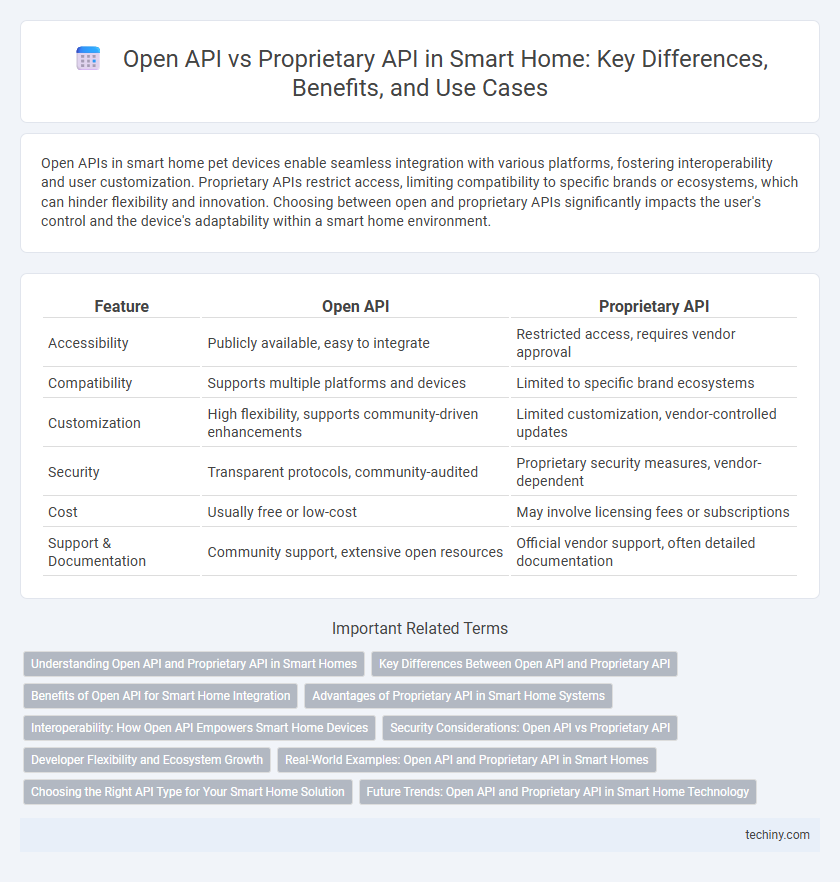Open APIs in smart home pet devices enable seamless integration with various platforms, fostering interoperability and user customization. Proprietary APIs restrict access, limiting compatibility to specific brands or ecosystems, which can hinder flexibility and innovation. Choosing between open and proprietary APIs significantly impacts the user's control and the device's adaptability within a smart home environment.
Table of Comparison
| Feature | Open API | Proprietary API |
|---|---|---|
| Accessibility | Publicly available, easy to integrate | Restricted access, requires vendor approval |
| Compatibility | Supports multiple platforms and devices | Limited to specific brand ecosystems |
| Customization | High flexibility, supports community-driven enhancements | Limited customization, vendor-controlled updates |
| Security | Transparent protocols, community-audited | Proprietary security measures, vendor-dependent |
| Cost | Usually free or low-cost | May involve licensing fees or subscriptions |
| Support & Documentation | Community support, extensive open resources | Official vendor support, often detailed documentation |
Understanding Open API and Proprietary API in Smart Homes
Open APIs in smart homes enable interoperability by allowing devices from different manufacturers to communicate through standardized protocols, enhancing user flexibility and system integration. Proprietary APIs restrict access to a specific brand's ecosystem, ensuring optimized performance and tighter security but limiting cross-device compatibility. Choosing between open and proprietary APIs impacts smart home scalability, device selection, and long-term customization options.
Key Differences Between Open API and Proprietary API
Open APIs in smart home systems offer standardized access, enabling seamless interoperability and third-party integration across diverse devices and platforms. Proprietary APIs restrict access to specific manufacturers, limiting compatibility but providing tailored features and enhanced security within their ecosystem. Understanding these differences is crucial for developers and consumers aiming to balance flexibility, control, and security in smart home automation.
Benefits of Open API for Smart Home Integration
Open APIs enhance smart home integration by enabling seamless interoperability between diverse devices and platforms, fostering a more cohesive user experience. They promote innovation through community-driven development and allow developers to create customized solutions without restrictions imposed by proprietary systems. Open APIs reduce vendor lock-in, offering consumers greater flexibility and long-term scalability for their smart home ecosystems.
Advantages of Proprietary API in Smart Home Systems
Proprietary APIs in smart home systems provide enhanced security by limiting access to a controlled ecosystem, reducing vulnerabilities associated with open access. These APIs enable seamless integration and optimized performance tailored to the specific devices and software of the manufacturer, ensuring a consistent user experience. Exclusive features and dedicated support further enhance customization and reliability in smart home automation.
Interoperability: How Open API Empowers Smart Home Devices
Open API enhances smart home interoperability by allowing diverse devices and platforms to communicate seamlessly, breaking down compatibility barriers inherent to proprietary APIs. It promotes standardized protocols and open communication channels, enabling users to integrate multiple manufacturers' products effortlessly under one unified control system. This openness accelerates innovation, increases device functionality, and offers greater flexibility for personalized smart home ecosystems.
Security Considerations: Open API vs Proprietary API
Open APIs in smart home systems enhance interoperability but may expose devices to higher security risks due to widely accessible interfaces, increasing vulnerability to unauthorized access. Proprietary APIs offer tighter security controls by restricting access to trusted developers, reducing potential attack vectors but limiting cross-platform compatibility. Careful assessment of encryption standards, authentication protocols, and update mechanisms is essential when choosing between Open and Proprietary APIs for secure smart home implementation.
Developer Flexibility and Ecosystem Growth
Open API standards in smart home systems provide developers with greater flexibility by enabling seamless integration across multiple devices and platforms, fostering innovation and customization. Proprietary APIs often limit access and interoperability, which can stifle developer creativity and slow the expansion of the smart home ecosystem. Embracing open APIs encourages a more dynamic developer community and accelerates ecosystem growth through shared resources and collaborative advancements.
Real-World Examples: Open API and Proprietary API in Smart Homes
Open APIs in smart homes, such as Apple's HomeKit and Google Home, enable seamless integration across diverse devices, fostering interoperability and user customization. Proprietary APIs, exemplified by Ring's security systems or Nest's thermostats, often offer specialized features but limit compatibility to specific ecosystems, potentially restricting device scalability. Real-world deployment shows that Open APIs enhance user flexibility and ecosystem growth, while Proprietary APIs drive innovation within tightly controlled environments tailored for optimized performance.
Choosing the Right API Type for Your Smart Home Solution
Selecting the ideal API for a smart home solution hinges on compatibility, flexibility, and security requirements. Open APIs facilitate seamless integration with various devices and platforms, enhancing interoperability and future-proofing your system. Proprietary APIs offer tailored functionality and potentially stronger security controls but may limit device choices and increase vendor dependency.
Future Trends: Open API and Proprietary API in Smart Home Technology
Open APIs in smart home technology enable seamless integration across diverse devices and platforms, fostering innovation and user customization through standardized protocols like REST and MQTT. Proprietary APIs, while limiting interoperability, offer enhanced security and tailored functionalities specific to brand ecosystems, essential for maintaining controlled environments. Future trends indicate a hybrid approach where open APIs drive ecosystem expansion, and proprietary APIs ensure secure, optimized performance for critical smart home applications.
Open API vs Proprietary API Infographic

 techiny.com
techiny.com